Corsair Vengeance Pro Review: 2x8 GB at DDR3-2400 10-12-12 1.65 V
by Ian Cutress on December 13, 2013 2:00 PM ESTCPU Real World
As mentioned previously, real world testing is where users should feel the benefits of spending more on memory. A synthetic test exacerbates a specific type of loading to get peak results in terms of memory read/write and latency timings, most of which are not indicative of the pseudo random nature of real-world workloads (opening email, applying logic). There are several situations which might fall under the typical scrutiny of a real world loading, such as video conversion/video editing. It is at this point we consider if the CPU caches are too small and the system is relying on frequent memory accesses because the CPU cannot be fed with enough data. It is these circumstances where memory speed is important, and it is all down to how the video converter is programmed rather than just a carte blanche on all video converters benefitting from memory. As we will see in the IGP Compute section of this review, anything that can leverage the IGP cores can be a ripe candidate for increased memory speed.
Our tests in the CPU Real World section come from our motherboard reviews in order to emulate potential scenarios that a user may encounter.
USB 3.0 Copy Test with MaxCPU
We transfer a set size of files from the 120GB OCZ Vertex3 connected via SATA 6 Gbps on the motherboard to the 240 GB OCZ Vertex3 SSD with a SATA 6 Gbps to USB 3.0 converter via USB 3.0 using DiskBench, which monitors the time taken to transfer. The files transferred are a 9.2 GB set of 7539 files across 1011 folders – 95% of these files are small typical website files, and the rest (90% of the size) are precompiled installers. In an update to pre-Z87 testing, we also run MaxCPU to load up one of the threads during the test which improves general performance up to 15% by causing all the internal pathways to run at full speed.
Results are represented as seconds taken to complete the copy test, where lower is better.
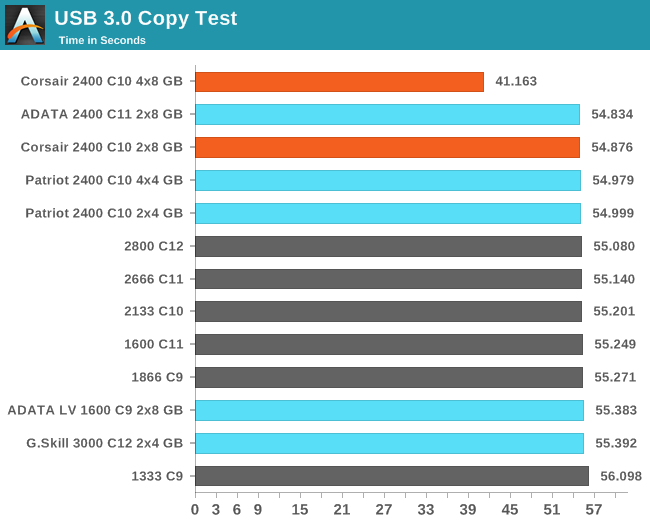
Our CPU copy results are not wholly unexpected, given our previous Ivy Bridge and Thunderbolt copy testing. When initiating a copy from one device to another, if the whole of the copy can fit into memory, it does so while the copy takes place and is faster. It would seem that when there is not enough memory, the system has to wait until a portion of the copy has finished before freeing up the system memory to be written to again. This has consequences, and thus when moving a lot of data around, having a large DRAM allocation can help (unless you go over the limit with a copy, and then almost all memory performs the same).
WinRAR 4.2
With 64-bit WinRAR, we compress the set of files used in the USB speed tests. WinRAR x64 3.93 attempts to use multithreading when possible, and provides as a good test for when a system has variable threaded load. WinRAR 4.2 does this a lot better! If a system has multiple speeds to invoke at different loading, the switching between those speeds will determine how well the system will do.
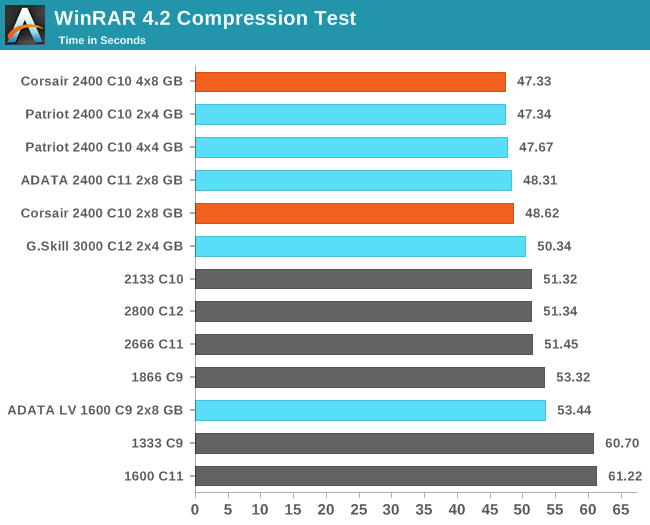
WinRAR seems to like high PI kits.
FastStone Image Viewer 4.2
FastStone Image Viewer is a free piece of software I have been using for quite a few years now. It allows quick viewing of flat images, as well as resizing, changing color depth, adding simple text or simple filters. It also has a bulk image conversion tool, which we use here. The software currently operates only in single-thread mode, which should change in later versions of the software. For this test, we convert a series of 170 files, of various resolutions, dimensions and types (of a total size of 163MB), all to the .gif format of 640x480 dimensions. Results shown are in seconds, lower is better.
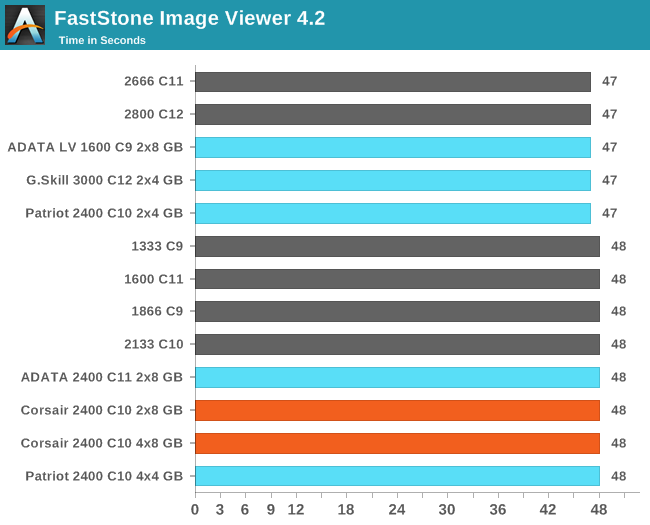
Xilisoft Video Converter 7
With XVC, users can convert any type of normal video to any compatible format for smartphones, tablets and other devices. By default, it uses all available threads on the system, and in the presence of appropriate graphics cards, can utilize CUDA for NVIDIA GPUs as well as AMD WinAPP for AMD GPUs. For this test, we use a set of 33 HD videos, each lasting 30 seconds, and convert them from 1080p to an iPod H.264 video format using just the CPU. The time taken to convert these videos gives us our result in seconds, where lower is better.
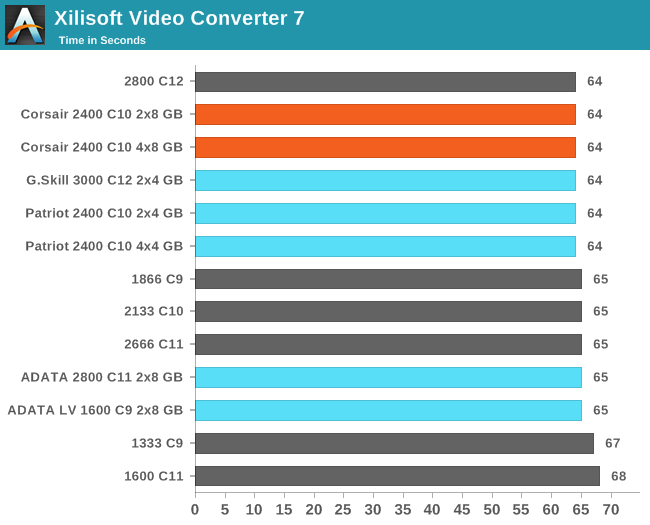
Video Conversion - x264 HD Benchmark
The x264 HD Benchmark uses a common HD encoding tool to process an HD MPEG2 source at 1280x720 at 3963 Kbps. This test represents a standardized result which can be compared across other reviews, and is dependent on both CPU power and memory speed. The benchmark performs a 2-pass encode, and the results shown are the average frame rate of each pass performed four times. Higher is better this time around.
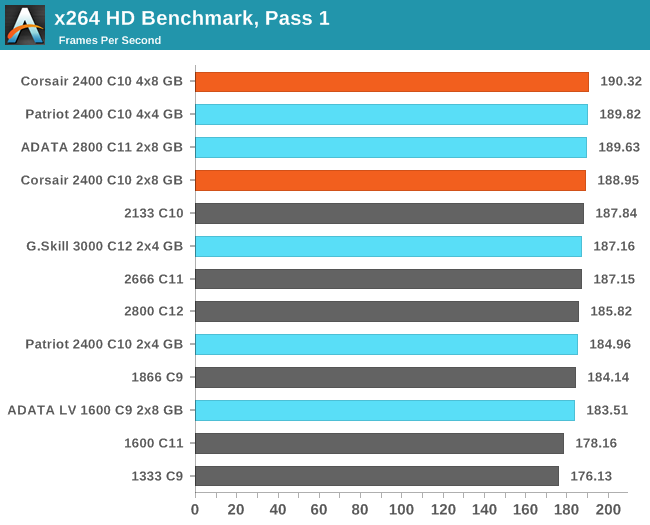
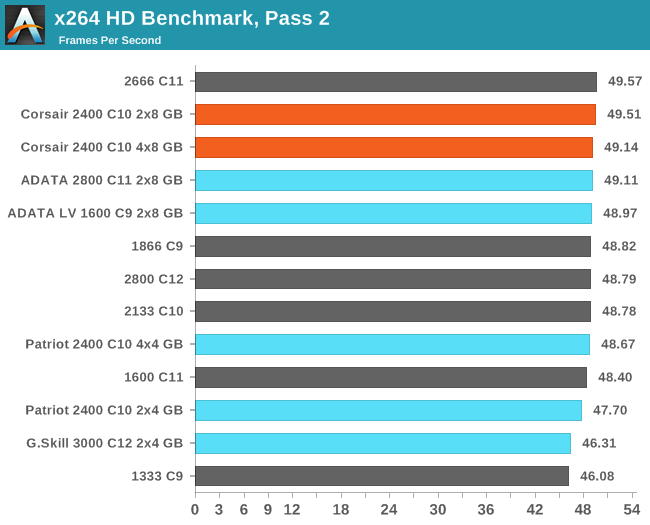
TrueCrypt v7.1a AES
One of Anand’s common CPU benchmarks is TrueCrypt, a tool designed to encrypt data on a hard-drive using a variety of algorithms. We take the program and run the benchmark mode using the fastest AES encryption protocol over a 1GB slice, calculating the speed in GB/s. Higher is better.
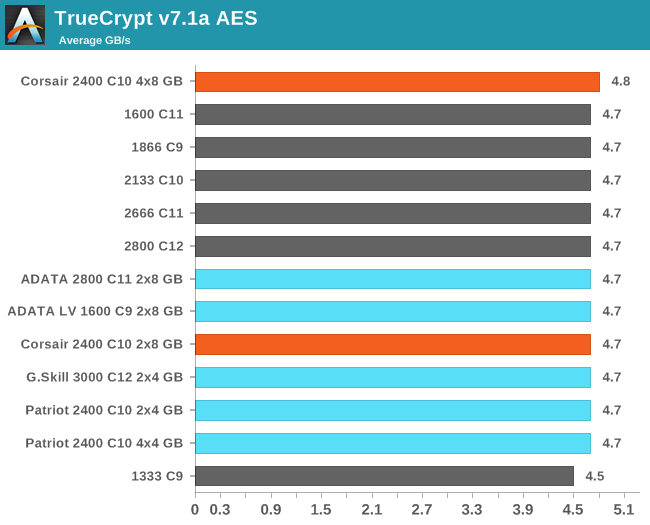










26 Comments
View All Comments
Hairs_ - Saturday, December 14, 2013 - link
A crossfire test is absolutely a valid metric, and testing with older generations of cpu and gpu is something I'm wholly in favour of. My issue is that if someone was buying a dual gpu setup, they would match the cards. If they upgraded after a time differential due to a budget concern, they might mix generations. I don't see a scenario where someone is buying dual+single, however, because if you had the budget to go for a top of the line dual card, you'd be better off with two cheaper cards in crossfire.Would people still have 4 gen old setups? Absolutely! Would they mix and match cards to suit a tight budget? Sure. Would any retail buyer follow *this* pattern? Vanishingly unlikely.
Egg - Sunday, December 15, 2013 - link
Wait, why wouldn't you use a 5970 and a 5870? Sure you lose a bit on clock speeds but it's exactly the same as triple 5870 otherwise, isn't it? And you save some slots.Perhaps someone wanted to do a really expensive water cooled microATX build with 4 slots. IDK, but it doesn't sound that farfetched in practice.
I haven't done this, or CF'ed anything at all, so this is just my two cents...
Hairs_ - Sunday, December 15, 2013 - link
Why? Like I said, there's no physical reason why you *couldn't*, but people use crossfire/sli for the same reason people overclock: to get top-line performance out of a smaller budget. The other use scenario is someone who wants bragging rights and doesn't care about the cost.For the primary, that user is not going to pay for a top line dual card when they could get similar numbers from two lower end cards. For the secondary use case, if money is no object (which it would have to be), why wouldn't you have bought two 5970's?
This example doesn't fit into any consumer behavior, so I have no idea why it would be used as a test.
Giffs - Friday, December 13, 2013 - link
No idea if there is any point in using winrar 4.2But there is winrar 5.01 why not using the latest version? wouldn't it bring improvements on the software side and more accurate results of some sorte??
sinPiEqualsZero - Saturday, December 14, 2013 - link
Thanks for the writeup. I'm shopping for memory and am happy I got to read this first.Also, I noticed an issue: " More expensive kits do not always equal performance, and as our benchmarks go, higher specification kits might also have little affect" should be effect with an e.
Thanks, Ian!
Hairs_ - Saturday, December 14, 2013 - link
There's no "might" about it. High spec kits make NO difference.Hairs_ - Saturday, December 14, 2013 - link
I wonder how it is that the entirely arbitrary "Performance Index" which was devised for memory testing isn't at all borne out by real-world data. Yet the bald statement"From the data in our memory overview, it was clear that any kit with a performance index of less than 200 was going to have issues on certain benchmarks. The Corsair kit has a PI of 240, which is at the higher end of the spectrum."
is still maintained.
There are no facts to back this statement up, as proved in the tests. Are Anandtech reviews going to continue to ignore factual data in favour of preconceived assumptions? I hope not.
Ytterbium - Saturday, December 14, 2013 - link
Explicit Finite Difference, in this graph you have 1333 C9 mid pack and 1866 C9 at bottom, I assume this is typo?Hairs_ - Saturday, December 14, 2013 - link
if you look at all the graphs, the results aren't consistent at all. The kit that top one graph can be bottom of the next. Furthermore, the differences between top and bottom scoring kits is negligible in almost all tests, so many of the differences in rank can be due to statistical variance rather than a meaningfully measured performance difference.E.g. in many tests, the fastest kit in terms of headline mhz (3ghz) is beaten by theoretically slower stuff.
Gen-An - Saturday, December 14, 2013 - link
I wonder if Corsair has purposely set out to make this kit look bad. Every single review I've seen of the Vengeance Pro 2x8GB 2400C10 kit has been Ver4.21, which uses Samsung 4Gbit B-die ICs and are infamous for not being able to clock much higher than about DDR3-2500 or so. I have four sticks of these and they are Ver5.29 using Hynix 4Gbit MFR and I've done Super Pi 32M runs at DDR3-3000 12-15-15-45 and they are rock solid at DDR3-2666 11-13-13.